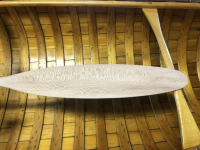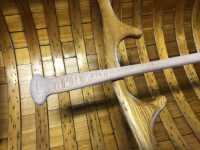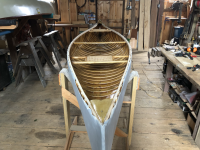If you can make some kind of a fence/jig type thing for the bandsaw, it should be no problem. I'm gonna ask our wood working guy tomorrow, cause planing is hard work! I've never seen this card scraper thing, what exactly is it?
-
Happy Marine Mammal Rescue Day! 🐳🐬🦭🦦
You are using an out of date browser. It may not display this or other websites correctly.
You should upgrade or use an alternative browser.
You should upgrade or use an alternative browser.
Time to make a new paddle
- Thread starter Patrick Corry
- Start date
Till Patrick signs in, it looks like a flat piece of steel, I have many of them even curved ones. Some people make them out of old handsaw blades, or you can buy them. The trick is to turn a burr on the edge, that does the cutting. I’m sure you can find more info by searching ‘card scraper’.
They are handy to have.
Jim
They are handy to have.
Jim
If you can make some kind of a fence/jig type thing for the bandsaw, it should be no problem. I'm gonna ask our wood working guy tomorrow, cause planing is hard work! I've never seen this card scraper thing, what exactly is it?
Super-Hard Curved Scraper Sets - Lee Valley Tools
Watco natural Danish Oil
You may know this, and how much difference it actually makes I know not, but Watco Danish is recommended for indoor use only, as on furniture. Watco Teak or Watco Exterior Wood are recommended for outdoor and marine uses. I've only used Watco Teak on paddles and gunwales. The Watco Exterior Wood seems to be a newer product.
Uh-oh... you've exposed my dearth of knowledge with respect to wood finishes. I have a couple of varnished paddles; a finish I do not like, at least on the shaft. Grips have previously always been oiled with boiled linseed oil. I have done a bit of reading about the use of Watco Danish Oil on paddles, and some makers seem to like it. I don't know the chemistry which differentiates Danish Oil from Exterior Finish and I suspect that the real culprit in a finish used for exterior is the long-term exposure to UV. Frankly, though a paddle blade may be immersed in water for hours at a time, unless left in the open for weeks on end, I think it may be hair-splitting to choose one oil finish over another. I have plenty of time before paddling season to apply and cure multiple coats of finish, hoping that that may make a difference. Besides, if I notice a failure in the finish, there will be time to repair if necessary before that failure becomes catastrophic. Even if it does... I'll just make another and learn from my error!
Having said that- if anyone has a strong opinion, or a suggestion for a protective (but non-coloring) alternative, please chime in.
Having said that- if anyone has a strong opinion, or a suggestion for a protective (but non-coloring) alternative, please chime in.
if anyone has a strong opinion, or a suggestion for a protective (but non-coloring) alternative, please chime in.
Refinishing wood gunwales
I need to refinish/maintain the wood gunwales on my Colden Dragonfly. Knowing nothing about the process, I thought it would be a matter of light sanding and an application of tung oil. This morning, I am learning, via google, I need to clean the wood with tri-sodium phosphate first. But TSP is...
www.canoetripping.net
What oil to use on a bare paddle shaft?
I have grown to be a little annoyed by the friction I feel on my varnished paddle shafts. My Sanborn has an oiled grip, but varnished shaft. I've gone ahead and sanded the shaft down to bare wood, leaving 6" or so of the blade end varnished. went to the local hardware store intending to pick up...
www.canoetripping.net
A little paddle maintenance - Bruce Smith & Fishell
I have gotten 2 new paddles since the holidays, and only used one: the 62” Bruce Smith cherry ottertail. I must say, I really love it. I was surprised how thin the shaft was upon receipt. I didn’t have an expectation I suppose, and didn’t think to discuss it with Bruce leading up to placing my...
www.canoetripping.net
That paddle looks exceptional … I can not wait too the final finish product … it is truly amazing!
That second one was helpful to me. Here are a couple of my paddle escapades; I used a BLO/spirits mixture to rub an oil finish in. One paddle has a varnished blade and oiled shaft and grip.
A little paddle maintenance - Bruce Smith & Fishell
I have gotten 2 new paddles since the holidays, and only used one: the 62” Bruce Smith cherry ottertail. I must say, I really love it. I was surprised how thin the shaft was upon receipt. I didn’t have an expectation I suppose, and didn’t think to discuss it with Bruce leading up to placing my...
www.canoetripping.net
Paddle mod / make it my own
So I have 3 Aviron Clement paddles. They have huge blades, and well, I don’t enjoy using them. They might be worth something, but getting them sold and shipped is a nuisance. I’d really like a Grey Owl Fleetwood or similar, so… I’m gonna make one. Or similar. The subject paddle is a 58” with an...
www.canoetripping.net
- Joined
- Aug 10, 2018
- Messages
- 948
- Reaction score
- 1,066
I'm always a fan of naturally-colored wood and that Sycamore looks really good. I may have to slice up a few of those trees myself....a clear finish may be best.
Looking forward to seeing the finished product and getting a weight; especially as compared to the "pattern" paddle. (I know it won't be exact as you modified the throat... are the final shapes similar enough to compare?)
Gorgeous wood and a beautifully made paddle, @Patrick Corry ! I love the look of that wood, and your paddles have great lines.
I'm on the cusp of attempting to make my first, and still debating what wood I might try. I've heard that cherry is a decent starter, but also heard the grain can be tough to figure out in terms of direction of planing. I've heard maple is easy in terms of grain but hard on blade edges. I've also heard sassafras is lovely to work with, and I love how it paddles, but not sure if I can get it around here at a reasonable price. What was your impression of working sycamore vs other woods? Do you know if quartersawn maple has the same ray pattern as your sycamore here?
I'm on the cusp of attempting to make my first, and still debating what wood I might try. I've heard that cherry is a decent starter, but also heard the grain can be tough to figure out in terms of direction of planing. I've heard maple is easy in terms of grain but hard on blade edges. I've also heard sassafras is lovely to work with, and I love how it paddles, but not sure if I can get it around here at a reasonable price. What was your impression of working sycamore vs other woods? Do you know if quartersawn maple has the same ray pattern as your sycamore here?
Tsuga8's post reminded me that i hadn't updated my post regarding final finish. I chose tung oil, and am happy with the result. I didn't want a finish to add color other than a faint amber hue, and the oil accomplished my goal. I'm glad that I didn't want to use the paddle right away since subsequent applications of the oil require patience between coats in order to allow proper polymerization of the oil within the grain.
Shown here on the filled canvas hull of my Chestnut Bobs Special project, both "A" and "B" sides.
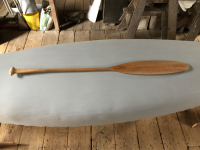
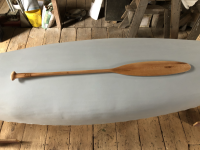
Interestingly, the "B" side, with its discoloration due to fungi entering wood boring insect channels, is the side most people admire for its "character". I tend to agree, it is interesting to look at. Finally, and just for fun, closeups of the discoloration... and my boots just got a fresh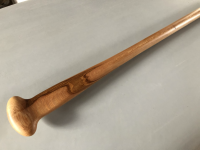
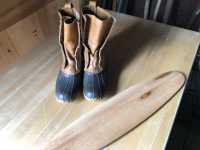 coat of Mink Oil.
coat of Mink Oil.
Tsuga8, my first paddles were made with single board Cherry. It can be subject to tear-out when planing the blade to near final thickness, so I resorted to an angle grinder flap disc sander (careful though, it's easy to go too far with this), my belt sander to come close to final shape, and I finish with a card scraper. The Sycamore also had minor tear out where the medullary rays emerge from the paddle face, but much less than the sometimes twisted grain of Cherry. Again, the card scraper is your friend and it removes material faster than finish sanding while leaving a smooth finish. Careful renewal of the burr on the scraper is a must to maintain a cutting action- if you're seeing dust off the card scraper rather than curls of fine wood you need to renew the burr.
Maple can have lots of different figure; i.e. birdseye, flame, tiger, etc. Also the distinctions among "hard", "rock", and "soft" Maple designations leave me a bit confused. I don't have experience with paddle making in Maple, but it's next along with Flame Birch so I'll be learning soon.
Lastly, Gamma1214... I don't have access to a scale so I don't really know about final weight, though it "feels" very similar. It's certainly lighter weight than my Cherry paddles. I tend to adjust to whatever weight paddle I am using and have never object to varying weights. I can't even imagine how a lightweight fiberglass paddle would feel, and I suspect it would spoil my view of wooden paddle use. Plus, a modern paddle would certainly look out of place in my w/c canoes so I'll probably never use them! Aesthetics are a big factor in my equipment choices for paddling.
Shown here on the filled canvas hull of my Chestnut Bobs Special project, both "A" and "B" sides.


Interestingly, the "B" side, with its discoloration due to fungi entering wood boring insect channels, is the side most people admire for its "character". I tend to agree, it is interesting to look at. Finally, and just for fun, closeups of the discoloration... and my boots just got a fresh

 coat of Mink Oil.
coat of Mink Oil.Tsuga8, my first paddles were made with single board Cherry. It can be subject to tear-out when planing the blade to near final thickness, so I resorted to an angle grinder flap disc sander (careful though, it's easy to go too far with this), my belt sander to come close to final shape, and I finish with a card scraper. The Sycamore also had minor tear out where the medullary rays emerge from the paddle face, but much less than the sometimes twisted grain of Cherry. Again, the card scraper is your friend and it removes material faster than finish sanding while leaving a smooth finish. Careful renewal of the burr on the scraper is a must to maintain a cutting action- if you're seeing dust off the card scraper rather than curls of fine wood you need to renew the burr.
Maple can have lots of different figure; i.e. birdseye, flame, tiger, etc. Also the distinctions among "hard", "rock", and "soft" Maple designations leave me a bit confused. I don't have experience with paddle making in Maple, but it's next along with Flame Birch so I'll be learning soon.
Lastly, Gamma1214... I don't have access to a scale so I don't really know about final weight, though it "feels" very similar. It's certainly lighter weight than my Cherry paddles. I tend to adjust to whatever weight paddle I am using and have never object to varying weights. I can't even imagine how a lightweight fiberglass paddle would feel, and I suspect it would spoil my view of wooden paddle use. Plus, a modern paddle would certainly look out of place in my w/c canoes so I'll probably never use them! Aesthetics are a big factor in my equipment choices for paddling.
Last edited:
Good info and a stunning paddle! Thanks for sharing!
Beautiful paddle and  on the bean boots/hunting shoes
on the bean boots/hunting shoes
Beautiful paddle, should look good in the newly canvased canoe too!
- Joined
- Apr 18, 2018
- Messages
- 2
- Reaction score
- 0
What is your crosscut technique? Are you using a table saw, bandsaw, skillsaw, or something else? Great stuff, thanks for posting the pictures and explanations.A little progress:
I used a pal's nice bandsaw to cut out the paddle shape
View attachment 138161
I then refined the profile with a home made disc sander on my table saw- I cut a 5/8" cabinet grade plywood disc, drilled a 5/8" arbor hole in the center, then affixed a 10" 80grit pressure sensitive adhesive backed sanding disc. Worked like a charm and only cost me $9 bucks!
View attachment 138162
The finished blank
View attachment 138163
Rough grip shaping. To remove the bulk of the material I crosscut the waste roughly, chiseled off the wood, then rough rasped the shape
View attachment 138164
I'm trying the same removal technique for the blade- I intensely dislike the screaming noise of my electric planer. My neighbors do also!
View attachment 138165
I think the most important reference lines are the center marks at top of grip and bottom of blade, and the lateral centerline around the entire paddle blank once band-sawed. With these you can always re-center your piece as the shaping progresses- to a point- then your 'eye' has to take over in determining fair curves where blade meets shaft, shaft meets grip, etc. It's a fun process, each time attempting to make the paddle a bit lighter and test the limits of durability and eye appeal!
More to come,
Similar threads
- Replies
- 18
- Views
- 2K
- Replies
- 10
- Views
- 2K
- Replies
- 61
- Views
- 10K
- Replies
- 30
- Views
- 2K

